Hybrid work schedules have become increasingly popular, especially in the wake of the COVID-19 pandemic. This forced many organizations to adopt remote work policies.
It’s estimated that by the end of 2023, 39% of global knowledge workers will work hybrid.
If your company is looking to implement a hybrid schedule, you couldn’t have picked a better place to start from to learn about a hybrid policy.
Today, we’re taking a deep dive into the secret of remote working.
We’ll talk about the types, benefits of the hybrid model, best practices, and more.
What is a hybrid work schedule?
A hybrid work schedule refers to a work arrangement that combines both remote work and in-person work in a flexible manner.
It allows employees to divide their work hours between working from a physical office location and working remotely from another location, such as their home or a coworking space. That way, remote employees can enjoy the perks of the remote lifestyle but still get some office time too.
Hybrid work - the different types of schedules
In hybrid models, employees typically have the freedom to choose when and where they work, within certain parameters set by their employer.
In general, we can distinguish 5 types of hybrid work:
Fixed onsite/remote days
In this model, employees have specific days designated for working in the office and other days for remote work schedules.
For example, they might have office days on Mondays, Wednesdays, and Fridays, while working from a remote location on Tuesdays and Thursdays.
PROS
Predictability: employees can plan their schedules in advance, knowing which days they will be working in the office and which days they can work remotely.
Enhanced collaboration: onsite work days allow for in-person collaboration, fostering face-to-face interactions and teamwork within the office schedule.
Cost savings: employees may save on commuting expenses and potentially reduce their carbon footprint by working remotely for some days.
CONS
Limited flexibility: employees may feel constrained by having specific fixed days for onsite and remote work, which can limit their ability to adapt to personal or changing circumstances.
Reduced autonomy: the fixed schedule may not align with an individual's peak productivity hours or personal preferences for when and where they work.
Office space constraints: if all employees have the same fixed onsite days, it may lead to overcrowding in the office on those particular days, potentially affecting productivity, employee engagement, and comfort levels.
Rotating shifts
With this approach, teams or departments rotate their onsite and remote work days or weeks.
For instance, Team A might work from the office during the first week and on a remote schedule during the second week, while Team B follows the opposite pattern.
This allows for shared office space utilization and provides equal opportunities for in-person collaboration.
PROS
Fairness and equality: rotating shifts ensure that all employees have an opportunity to experience both onsite and remote work, promoting a sense of fairness and shared responsibilities.
Resource optimization: by rotating shifts, organizations can effectively manage office space utilization and equipment availability, avoiding overcrowding or underutilization.
Improved collaboration and cross-Functional exchange: rotating shifts can encourage interactions and collaboration among different teams or departments, promoting knowledge sharing and diverse perspectives.
CONS
Disrupted routine: frequent shifts between onsite and remote work may disrupt employees' routines and work-life balance, making it harder to establish a consistent schedule.
Communication challenges: with teams constantly switching between onsite and remote work, maintaining effective communication and coordination can be more challenging.
Reduced continuity: the rotation of shifts may result in decreased continuity in projects or tasks, as different team members take turns being physically present in the office.
Core hours/remote flexibility
In this model of a flexible schedule, there are specific core hours during which employees are expected to be available for collaboration and meetings in the office.
Outside of these core hours, employees have flexibility in choosing their work location, whether it's in the office or remote.
PROS
Balance of collaboration and flexibility: core hours ensure that employees are available for synchronous collaboration while allowing flexibility in choosing their work location for the rest of their workday.
Increased focus and productivity: remote work flexibility can enable employees to work during their most productive hours or in an environment that enhances their concentration and creativity.
Employee empowerment: providing flexibility in work location can boost employee morale, satisfaction, and engagement, as they have a sense of control over their work environment.
CONS
Coordination challenges: with employees having different schedules for core hours and remote work, coordinating meetings and collaborative work can be more complex and require careful planning.
Potential for misalignment: if employees have overlapping core hours but choose to work remotely during that time, it may hinder real-time communication and impede team synergy.
Inconsistent availability: if employees have too much flexibility in choosing their work location, it can lead to challenges in scheduling meetings or resolving urgent issues, especially when team members are dispersed across different time zones.
Split weeks
In a split-week schedule, employees work a combination of onsite and remote days within the same week.
For example, an employee might work from the office on Monday and Tuesday, take Wednesday as a remote work day, and then return to the office on Thursday and Friday.
PROS
Balanced Work-Life Integration: split weeks allow employees to experience a combination of onsite and remote work within the same week, promoting a better integration of work and personal life, for remote workers and those who are in the office.
Enhanced flexibility: hybrid employees can adjust their work location based on the nature of their tasks or personal needs, optimizing their productivity and well-being.
Increased Collaboration Opportunities: onsite work days provide dedicated time for face-to-face interactions for the office employees, fostering collaboration, team building, and the exchange of ideas.
CONS
Disruption to Workflow: splitting the week between onsite and remote work may interrupt the flow of work and require additional effort from hybrid employees to adjust to different work environments.
Difficulty in planning and scheduling: coordinating meetings and aligning schedules among team members who have different onsite and remote work days can be challenging and time-consuming.
Potential for Communication Gaps: when team members are physically separated on different days, it may lead to delays or miscommunication, impacting collaboration and decision-making.
Ad hoc Hybrid
This flexible approach allows employees to choose their work location on a day-to-day basis based on their needs and preferences.
They can switch between working in the office and remotely as required, without following a fixed schedule.
PROS
Maximum flexibility: ad hoc hybrid allows employees to decide their work location on a day-to-day basis, empowering them to choose the setting that suits their needs and preferences.
Agility and adaptability: this model enables employees to respond quickly to personal commitments, external circumstances, or work demands that may require a change in their work location.
Individualized productivity pptimization: employees can tailor their work environment based on their personal preferences, allowing them to optimize their productivity and focus.
CONS
Coordination and planning challenges: ad hoc hybrid requires strong communication and coordination to ensure that team members are aware of each other's availability and work location, which can be time-consuming.
Potential for inconsistency: with employees constantly changing their work location, maintaining consistency in communication, collaboration, and work processes may become more difficult.
Reduced in-person interaction: if employees frequently choose to work remotely, it may limit in-person interactions, which can affect team dynamics, spontaneous brainstorming, and relationship-building in a hybrid team.
Should you implement hybrid work in your workplace?
Are you debating whether or not you should introduce hybrid work in your workplace?
Check these statistics out. They will help clear your mind.
- 80% of employees want a hybrid schedule (McKinsey, 2023)
- Hybrid work has the power to let your hybrid employees save money (76%), improve physical health (68%), improve family relationships (74%), be happier (82%) and decrease stress levels (55%) (Cisco, 2022)
- 83% of workers around the globe prefer a hybrid working model (Accenture, 2022)
- A hybrid workplace lets workers save +4 hours of their time every week, which can improve their productivity, satisfaction, and performance (Cisco, 2022)
- 55% of employees can be productive anywhere they are, be it onsite or in a hybrid setup (Accenture, 2022).
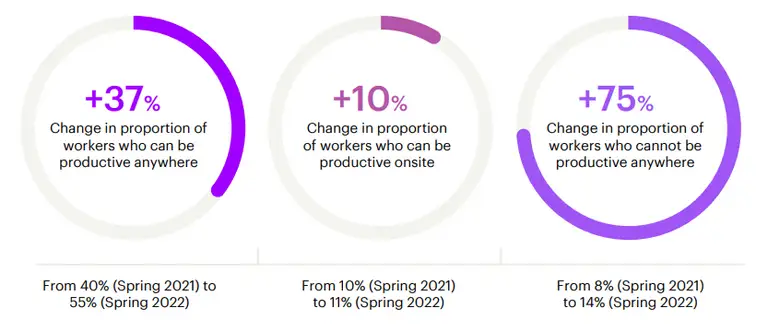
- Working in a hybrid work schedule model positively impacts workplace and talent retention (Cisco, 2022)
- Employers of hybrid workers can expect more productivity, better performance, higher employee engagement, retention, and more profitability (Forbes, 2021)
- Hybrid work options have the power to improve employee work-life balance, well-being, performance, and company culture (Cisco, 2022)
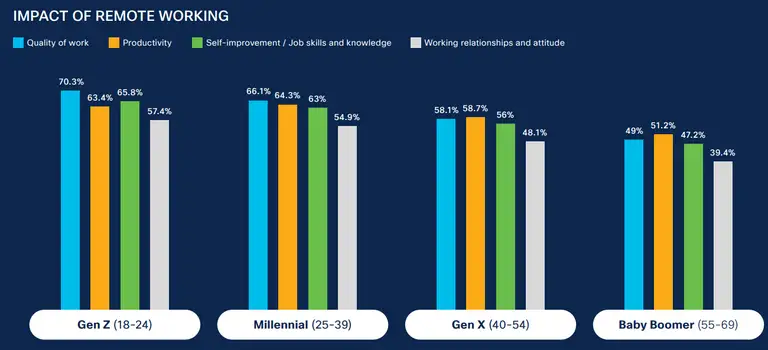
- Nearly 70% of employees are more punctual for online rather than face-to-face work meetings.
The best practices for a hybrid work schedule
If you’re thinking about giving a hybrid work model a try, follow these practices to set yourself up for success:
Set core hours
Proper hybrid work scheduling is beneficial for promoting collaboration, communication, and teamwork among hybrid teams.
These are specific hours or days per week during which all team members are expected to be available and accessible for virtual meetings, discussions, and synchronous work.
Core hours facilitate real-time interactions and reduce the chances of miscommunication or delays.
Implement time tracking
Implementing a reliable time tracking system for the following reasons:
- it helps monitor productivity,
- it ensures accountability, and
- it enables efficient management of work hours.
Time tracking tools like Unrubble can provide insights into how employees allocate their time, identify potential bottlenecks, and assist in managing workloads and deadlines.
Unrubble helps you by providing features such as:
In a convenient way, you can easily watch how your employees work: both in the office and outside of it.
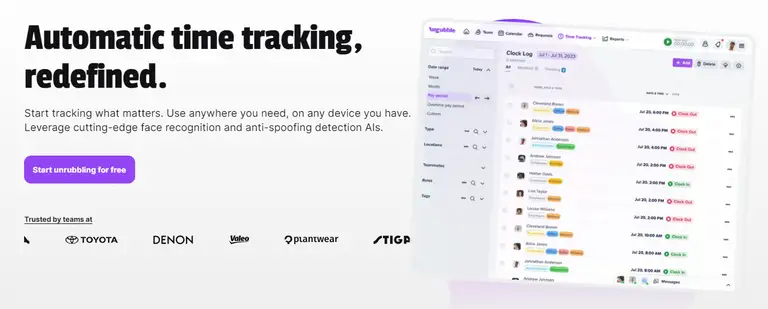
We also offer seamless integrations, including payroll system integrations for simple billing.
Do consider using our software if you want insights into your employees’ productivity delivered to your pc or mobile app.
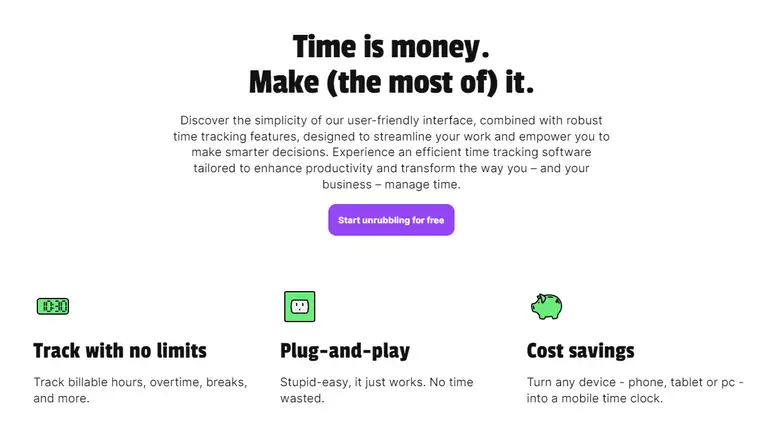
Set clear communication and expectations
Effective communication is crucial in a hybrid work environment. In fact, for over 50% of workers, it’s an important aspect.
Establish clear hybrid work policies and expectations regarding communication with team members, response times, and availability.
Utilize tools like instant messaging platforms, video conferencing, project management software, and shared calendars to facilitate seamless communication and collaboration.
Provide collaboration tools and technology
Equip employees with the necessary tools and technology to effectively collaborate and communicate in the hybrid environment. Research shows over 50% of employees require this. The tools should work regardless of employees’ location.
Invest in reliable:
- video conferencing,
- file sharing,
- communication, and
- project management tools
that promote virtual collaboration, document sharing, and real-time updates.
💡 Example:
Video Conferencing: Zoom, Microsoft Teams, or Google Meet
Project Management: Asana, Trello, or Jira
File Sharing & Document Collaboration: Google Drive, Microsoft OneDrive, or Dropbox
Communication and Instant Messaging: Slack, Microsoft Teams, or Discord
Foster Inclusion and Team Bonding
Promote inclusivity and maintain team cohesion by organizing regular virtual team meetings, brainstorming sessions, and social events.
Encourage informal communication and create opportunities for team members to interact and build relationships, even if they are not physically present in the same location.
💡 Example:
Company XYZ organizes regular virtual team meetings and brainstorming sessions.
These meetings serve as a platform for team members to collaborate, share ideas, and contribute to the overall success of the team.
The company ensures that everyone has the opportunity to participate and be heard, regardless of their physical location.
Provide flexibility and autonomy
Embrace the flexible work arrangement and autonomy that hybrid work provides.
Trust employees to manage their work schedules and deliverables effectively. Try not to promote toxic productivity.
Focus on outcomes rather than micromanaging, allowing employees to work at their most productive times and in environments that suit them best.

💡 Example:
Employees at ABC Enterprises have the freedom to manage their work schedules and deliverables effectively.
Instead of micromanaging, the emphasis is on outcomes and results.
The management team trusts their employees to prioritize tasks, meet deadlines, and achieve goals in a way that suits their individual work styles.
Have regular check-ins and performance feedback
Conduct regular check-ins with employees. This is to make sure they are adjusting well to the hybrid work schedule. Try addressing any challenges they may be facing, and provide support and feedback.
Regular performance evaluations and feedback sessions:
- help track progress,
- provide guidance, and
- maintain a sense of professional development.
💡 Example:
Every quarter, each employee has a scheduled check-in meeting with their immediate supervisor.
During these meetings, the supervisor discusses the employee's progress, addresses any challenges they may be facing, and provides support and guidance.
The meetings serve as an opportunity to assess the employee's adjustment to the hybrid work schedule, as well as their overall performance and professional development.
Provide training and support
Finally, do offer training and support to employees. This will help them navigate remote work tools and technologies effectively.
Provide training and guidance on things like:
- time management,
- work-life balance, and
- maintaining well-being in a hybrid work environment.
You might also consider hiring a training company that will train your staff on hybrid work.
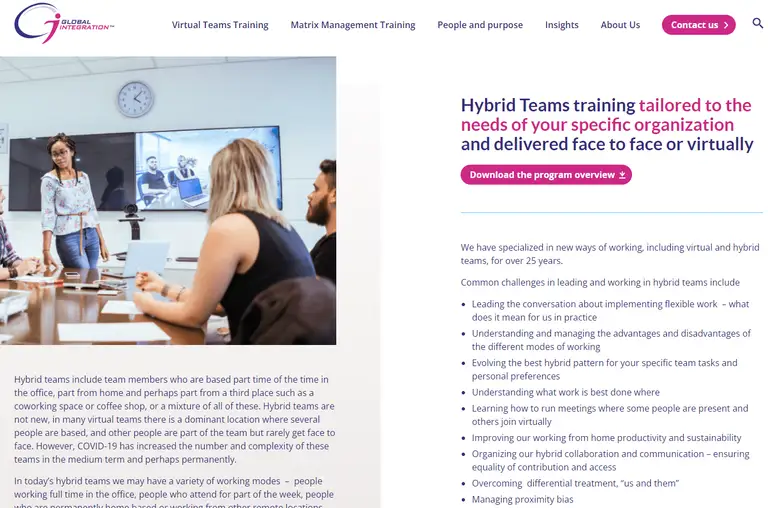
Conclusion
Embracing a hybrid work model can bring numerous benefits to both employees and organizations.
By following our best practices, including using time tracking software like Unrubble, you can successfully maximize the advantages of hybrid work.
Remember, hybrid work arrangements are not just a trend; they're a flexible and adaptable approach.
It can enhance productivity, employee satisfaction, work-life balance, and overall company performance.
So, don't wait any longer.
Embrace the future of work and reap the rewards of a well-implemented hybrid work strategy.
Happy hybrid working!
P.S. If you liked this article, check our blog for similar releases.
P.S.2 If you want to give Unrubble a try, take advantage of our free trial here.
FAQ
What is a hybrid work schedule?
A hybrid work schedule combines remote work and in-person work, allowing employees to divide their time between a physical office location and another remote location.
What are the types of hybrid work schedules?
The types of hybrid work schedules include fixed onsite/remote days, rotating shifts, core hours/remote flexibility, split weeks, and ad hoc hybrid.
What are the benefits of a hybrid work schedule?
Hybrid work schedules offer benefits such as predictability, cost savings, enhanced collaboration, fairness, resource optimization, increased flexibility, and balanced work-life integration.
Should my company implement a hybrid work schedule?
Yes, considering that 80% of employees want a hybrid schedule, and it improves productivity, satisfaction, work-life balance, employee engagement, and talent retention.
What are the best practices for implementing a hybrid work schedule?
Set core hours, implement time tracking, establish clear communication and expectations, provide collaboration tools, foster inclusion, provide flexibility and autonomy, have regular check-ins and feedback, and offer training and support.








